
My Uncle Jerry Blazer was a house-painted by trade. He and his wife, my Aunt Clementine, lived with my grandparents in a big house that they’d all moved into simultaneously around 1955. So he was a constant fixture in my life, though not seen quite so often as my Grandparents were. He was also the one person among that older crown who took an active interest in my interests. Not having had any children of his own, I as the first-born Grand-nephew enjoyed a privileged place in his heart. And so, he’d be the one to willingly listen to me drone on about the Justice Society of America for hours, despite the fact that he could not have had any less interest in the topic.
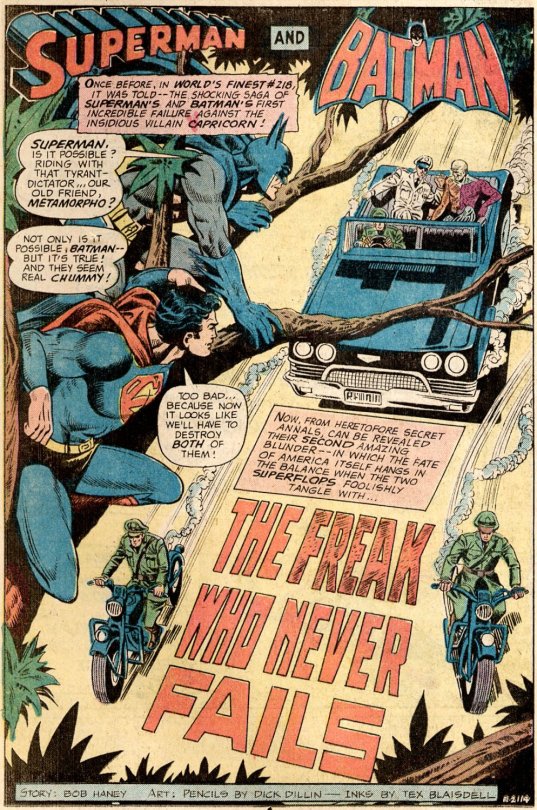
He was also an infrequent source of comic books. I still have issues that my Aunt had dutifully written my name on before giving them to me–there were four kids in our household and she thought she was doing me a favor in this. It was an annoyance at the time, a cherished memory today. In any event, one summer day while he had come to our home for a visit, my Uncle Jerry presented me with three comic books. He had gotten them at a recent house-painting job, left behind by the departing owner. Manna from heaven.

The first of the three was a copy of SHAZAM #15, a comic book that I’d already bought. But in the time between then and then, I had traded it away for something else, probably to my neighbor Johnny Rantinella. The third book was a copy of MARVEL TALES #53, which I’ll cover in-depth tomorrow. But the second book was this lovely 100-Page Super-Spectacular issue of WORLD’S FINEST COMICS–the format I loved which had gone the way of the dinosaurs. And so despite the fact that I knew that WF was one of those books that always read “wrong” to me, I dove in with both feet.
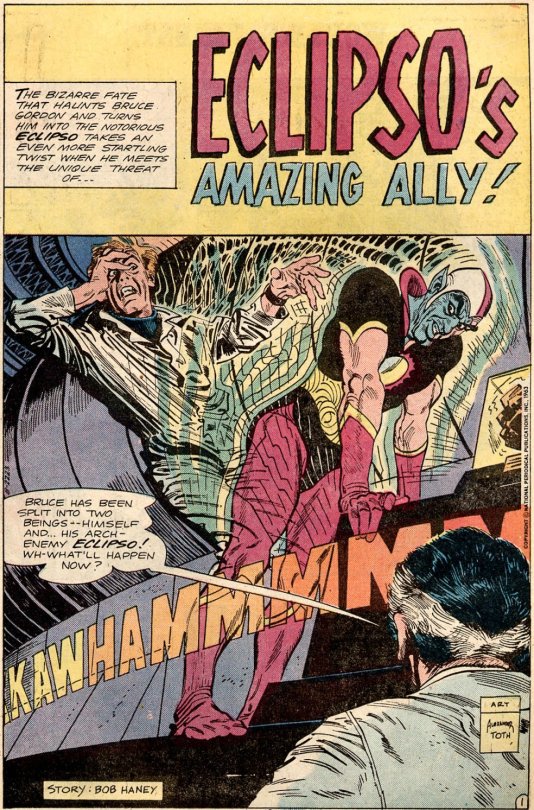
The first story is a vintage Bob Haney classic, in which Superman and Batman cross paths with Haney’s creation Metamorpho as they try to rescue a missing scientist from the stereotypical South American dictator El Jefe. Thing is, the rescue mission is a cover for an assassination attempt on the President, as a stand-in for the abducted scientist has been infected with a virulent plague. The idea is that he will be rescued, come into contact with the American president, and then infect him and the rest of the U.S. Despite some typical Bob Haney bumbling (and the annoying penchant Batman has during this period for addressing his comrade as “Supes”) the three heroes, in particular Metamorpho, prevent this from happening, and El Jefe doesn’t make it out of the story alive.
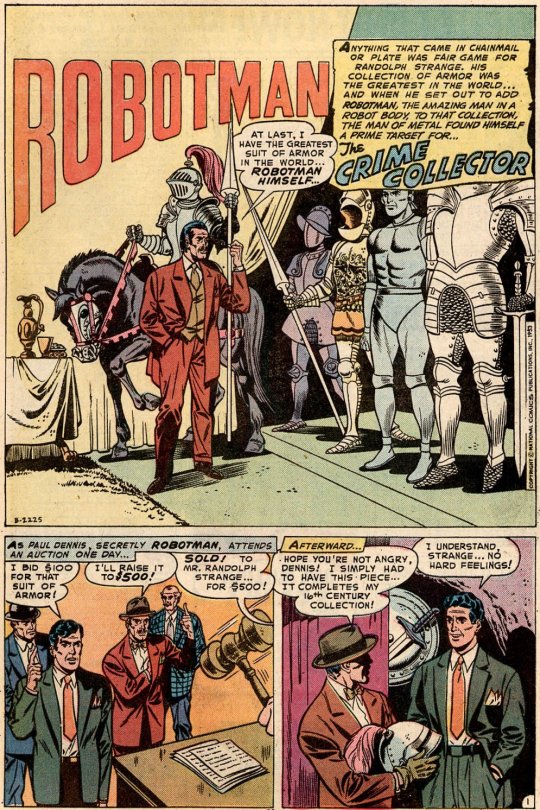
The reprints were varied but a little bit of a mixed bag, especially to my tastes back then. They started off with a Joe Simon and Jack Kirby Sandman adventure from around 1942. It’s a typically fun outing from the pair, but I still hadn’t quite cracked the “Kirby code” and so there was something about the artwork that I found to be a turn-off. Similarly, the Alex Toth art on the Eclipso story that followed was dark and scratchy and full of menace–and as such, it made me uneasy despite a fun outing for the Hero And Villain In One Man.

I liked the short Robotman feature that followed, as generic as it was, though I had a hard time reconciling it with the Robotman I had recently met as a member of the Doom Patrol. I somewhat-correctly intuited that this must be the Earth-2 Robotman, and could thereafter sleep soundly. After that came a Neal Adams Deadman story. At the time I was reading this book, Adams’ legend could not have burned more brightly. He was everybody’s favorite artist, and talked about constantly. And yet, I must confess that I found this Deadman story (and many of the others) incredibly boring. Nice enough to look at, but written on the level of any TV cop show. And that wasn’t what I wanted from my comic book. Plus, how do you root for a dead guy? What’s going to hurt him? What danger can he ever be in? I didn’t dig it.
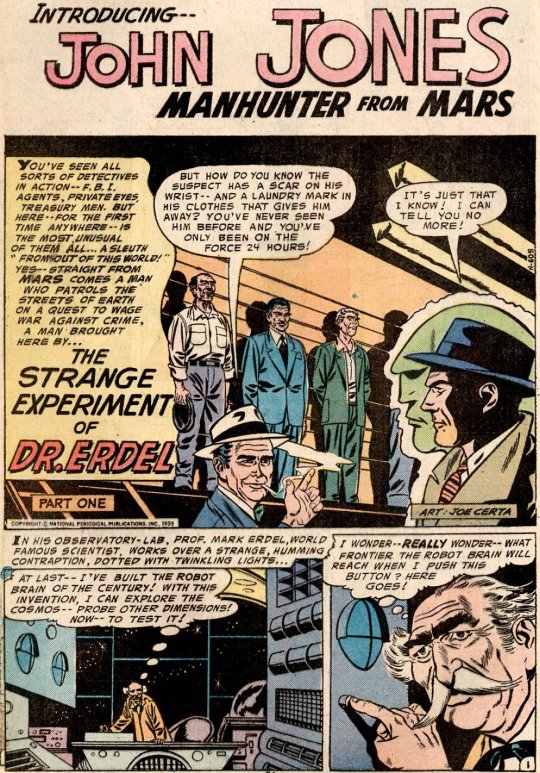
The real gems (to me) nestled within this issue of WORLD’S FINEST were right at the back–the first two installments of John Jones, Manhunter From Mars. I knew John (or J’onn) as a charter member of the Justice League of America–but long before the series had been slanted in the direction of super hero adventure, it had been launched as a gimmick detective series. In the same way that Roy Raymond, TV Detective solved crimes on the air, and Captain Compass solved crimes on the seas, John Jones tapped into the growing interest in space-travel and life on other planets to introduce a detective who solved crimes using unearthly means. These stories were all six pages long, filler-features used to back up more important stars. Nobody involved would have dreamed that J’onn J’onzz would still be a going concern in the 21st Century.
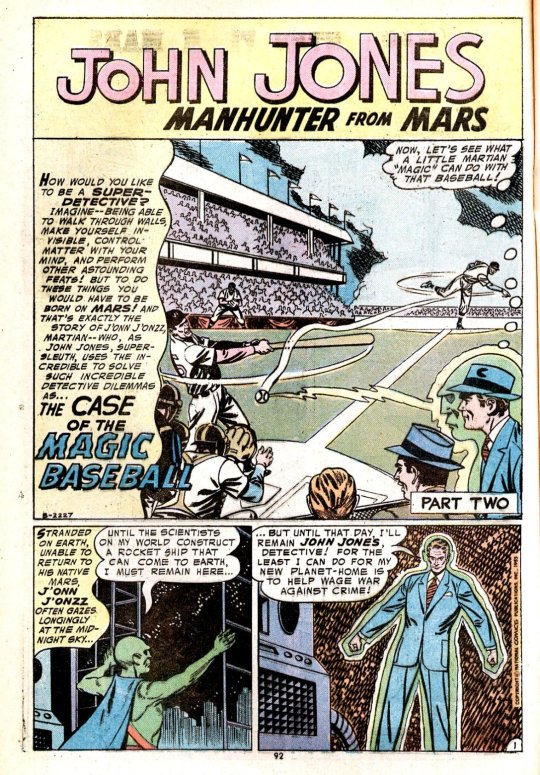
The first story sets up the series premise: scientist Dr Erdel attempts to contact Mars with his “robot brain” device, and succeeds in drawing a Martian to Earth with it. But Erdel is so shocked by his success that he has a heart attack and dies, leaving the Martian J’onn J’onzz trapped permanently on our world. Like many immigrants, he Americanizes his name to John Jones and uses his powers to secure himself a position on the Police force as a Detective, using his other-worldly abilities to battle crime on his new home. The second story involved an ex-con turned professional baseball pitcher whose old cronies were pressuring him to throw a big game they had bet on. Jones, having used his powers to peer into the future and learn what the outcome would be, uses Martian mind-over-matter to give the conflicted ballplayer his win, and to round up the criminals. And all in six pages.
